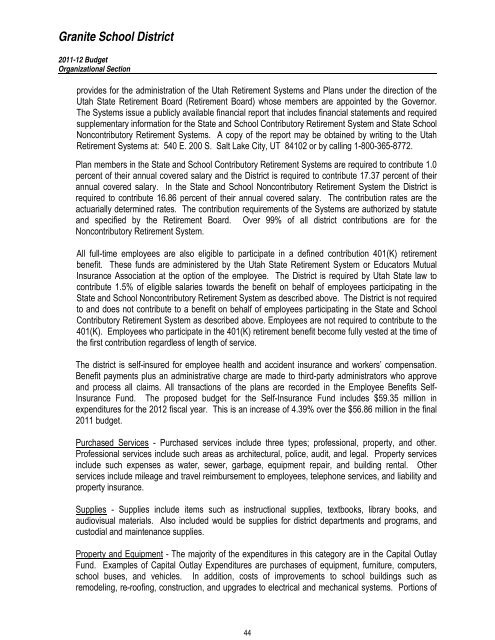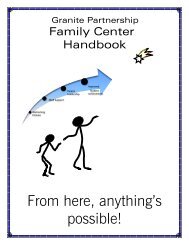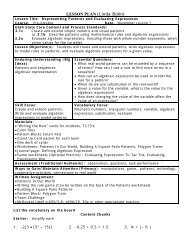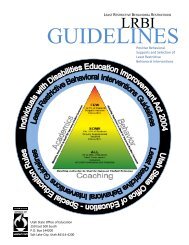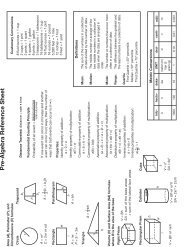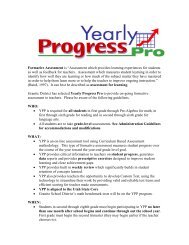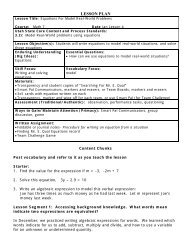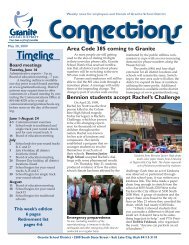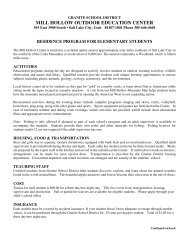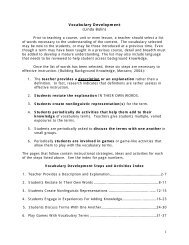2011T12 ANNUAL BUDGET - Granite School District
2011T12 ANNUAL BUDGET - Granite School District
2011T12 ANNUAL BUDGET - Granite School District
Create successful ePaper yourself
Turn your PDF publications into a flip-book with our unique Google optimized e-Paper software.
<strong>Granite</strong> <strong>School</strong> <strong>District</strong><br />
2011-12 Budget<br />
Organizational Section<br />
provides for the administration of the Utah Retirement Systems and Plans under the direction of the<br />
Utah State Retirement Board (Retirement Board) whose members are appointed by the Governor.<br />
The Systems issue a publicly available financial report that includes financial statements and required<br />
supplementary information for the State and <strong>School</strong> Contributory Retirement System and State <strong>School</strong><br />
Noncontributory Retirement Systems. A copy of the report may be obtained by writing to the Utah<br />
Retirement Systems at: 540 E. 200 S. Salt Lake City, UT 84102 or by calling 1-800-365-8772.<br />
Plan members in the State and <strong>School</strong> Contributory Retirement Systems are required to contribute 1.0<br />
percent of their annual covered salary and the <strong>District</strong> is required to contribute 17.37 percent of their<br />
annual covered salary. In the State and <strong>School</strong> Noncontributory Retirement System the <strong>District</strong> is<br />
required to contribute 16.86 percent of their annual covered salary. The contribution rates are the<br />
actuarially determined rates. The contribution requirements of the Systems are authorized by statute<br />
and specified by the Retirement Board. Over 99% of all district contributions are for the<br />
Noncontributory Retirement System.<br />
All full-time employees are also eligible to participate in a defined contribution 401(K) retirement<br />
benefit. These funds are administered by the Utah State Retirement System or Educators Mutual<br />
Insurance Association at the option of the employee. The <strong>District</strong> is required by Utah State law to<br />
contribute 1.5% of eligible salaries towards the benefit on behalf of employees participating in the<br />
State and <strong>School</strong> Noncontributory Retirement System as described above. The <strong>District</strong> is not required<br />
to and does not contribute to a benefit on behalf of employees participating in the State and <strong>School</strong><br />
Contributory Retirement System as described above. Employees are not required to contribute to the<br />
401(K). Employees who participate in the 401(K) retirement benefit become fully vested at the time of<br />
the first contribution regardless of length of service.<br />
The district is self-insured for employee health and accident insurance and workers’ compensation.<br />
Benefit payments plus an administrative charge are made to third-party administrators who approve<br />
and process all claims. All transactions of the plans are recorded in the Employee Benefits Self-<br />
Insurance Fund. The proposed budget for the Self-Insurance Fund includes $59.35 million in<br />
expenditures for the 2012 fiscal year. This is an increase of 4.39% over the $56.86 million in the final<br />
2011 budget.<br />
Purchased Services - Purchased services include three types; professional, property, and other.<br />
Professional services include such areas as architectural, police, audit, and legal. Property services<br />
include such expenses as water, sewer, garbage, equipment repair, and building rental. Other<br />
services include mileage and travel reimbursement to employees, telephone services, and liability and<br />
property insurance.<br />
Supplies - Supplies include items such as instructional supplies, textbooks, library books, and<br />
audiovisual materials. Also included would be supplies for district departments and programs, and<br />
custodial and maintenance supplies.<br />
Property and Equipment - The majority of the expenditures in this category are in the Capital Outlay<br />
Fund. Examples of Capital Outlay Expenditures are purchases of equipment, furniture, computers,<br />
school buses, and vehicles. In addition, costs of improvements to school buildings such as<br />
remodeling, re-roofing, construction, and upgrades to electrical and mechanical systems. Portions of<br />
44


